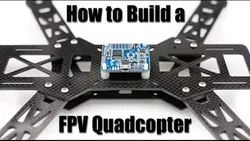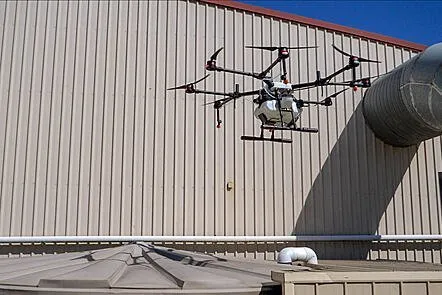
How to Build a FPV Quadcopter: Part 1 
This course provides a step-by-step guide on how to build a FPV Quadcopter. It includes a list of parts used, a schematic/diagram, instructions on how to assemble the frame, layout of components and Naze32 orientation, and instructions on how to solder the ESC's and Naze32. It also covers how to install the motors and propellers, as well as how to configure the Naze32. ▼
ADVERTISEMENT
Course Feature
![]() Cost:
Cost:
Free
![]() Provider:
Provider:
Youtube
![]() Certificate:
Certificate:
Paid Certification
![]() Language:
Language:
English
![]() Start Date:
Start Date:
On-Demand
Course Overview
❗The content presented here is sourced directly from Youtube platform. For comprehensive course details, including enrollment information, simply click on the 'Go to class' link on our website.
Updated in [February 21st, 2023]
Nighthawk 250 Combo contents:
Parts Used in this build:
Schematic/diagram for a FPV Quadcopter:
Assemble the frame:
Layout of components and Naze32 orientation:
Soldering the ESC's:
Installing the Naze32:
Soldering the Naze32:
Connect the ESC's to the Naze32:
Naze32 VBATT:
Connect power cable with wire mesh:
Mounting the CW/CCW Motors:
Install the receiver:
(Please note that we obtained the following content based on information that users may want to know, such as skills, applicable scenarios, future development, etc., combined with AI tools, and have been manually reviewed)
This course provides an introduction to building a FPV Quadcopter. Learners will gain an understanding of the parts used in the build, the schematic/diagram for a FPV Quadcopter, how to assemble the frame, the layout of components and Naze32 orientation, soldering the ESC's, installing the Naze32, soldering the Naze32, connecting the ESC's to the Naze32, Naze32 VBATT, connecting power cable with wire mesh, mounting the CW/CCW Motors, and installing the receiver. This course is ideal for those who are interested in learning the basics of drone building, construction, and assembly. It is also suitable for those who are looking to build their own FPV Quadcopter from scratch. Learners will gain the knowledge and skills necessary to build a drone DIY.
[Applications]
After completing this course, participants should be able to apply the knowledge they have gained to build a FPV Quadcopter. They should be able to identify the parts used in the build, understand the schematic/diagram for a FPV Quadcopter, assemble the frame, layout the components and Naze32 orientation, solder the ESC's, install the Naze32, solder the Naze32, connect the ESC's to the Naze32, connect the power cable with wire mesh, mount the CW/CCW Motors, and install the receiver.
[Career Paths]
1. Drone Pilot: Drone pilots are responsible for operating unmanned aerial vehicles (UAVs) for a variety of purposes, such as aerial photography, surveillance, and search and rescue operations. The demand for drone pilots is expected to grow significantly in the coming years as the technology becomes more widely used.
2. Robotics Engineer: Robotics engineers design, build, and maintain robots for a variety of applications, such as manufacturing, medical, and military. They must have a strong understanding of robotics, electronics, and computer programming. The demand for robotics engineers is expected to grow as the technology becomes more advanced and more widely used.
3. Drone Technician: Drone technicians are responsible for maintaining and repairing drones and other unmanned aerial vehicles (UAVs). They must have a strong understanding of electronics, computer programming, and robotics. The demand for drone technicians is expected to grow as the technology becomes more widely used.
4. Drone Software Developer: Drone software developers are responsible for developing software for drones and other unmanned aerial vehicles (UAVs). They must have a strong understanding of computer programming, software engineering, and robotics. The demand for drone software developers is expected to grow as the technology becomes more widely used.
[Education Paths]
1. Aerospace Engineering: Aerospace engineering is a field of engineering that focuses on the design, development, and testing of aircraft, spacecraft, and related systems. This field is rapidly evolving due to advances in technology and the need for more efficient and reliable aircraft. Aerospace engineers are in high demand and the job outlook is expected to remain strong in the coming years.
2. Robotics Engineering: Robotics engineering is a field of engineering that focuses on the design, development, and implementation of robots and robotic systems. Robotics engineers are in high demand and the job outlook is expected to remain strong in the coming years. Robotics engineers are responsible for designing, building, and testing robots and robotic systems for a variety of applications, including manufacturing, healthcare, and military applications.
3. Computer Science: Computer science is a field of study that focuses on the design, development, and implementation of computer systems and software. Computer scientists are in high demand and the job outlook is expected to remain strong in the coming years. Computer scientists are responsible for designing, building, and testing computer systems and software for a variety of applications, including web development, artificial intelligence, and machine learning.
4. Electrical Engineering: Electrical engineering is a field of engineering that focuses on the design, development, and implementation of electrical systems and components. Electrical engineers are in high demand and the job outlook is expected to remain strong in the coming years. Electrical engineers are responsible for designing, building, and testing electrical systems and components for a variety of applications, including power generation, communications, and automation.
Course Provider

Provider Youtube's Stats at AZClass
Discussion and Reviews
0.0 (Based on 0 reviews)
Explore Similar Online Courses

Brioche Knitting Made Easy

Free CCNA IPv4 Addressing (Part 1) Day 7 CCNA 200-301 Complete Course

Python for Informatics: Exploring Information

Social Network Analysis

Introduction to Systematic Review and Meta-Analysis

The Analytics Edge

DCO042 - Python For Informatics

Causal Diagrams: Draw Your Assumptions Before Your Conclusions

Whole genome sequencing of bacterial genomes - tools and applications

The Ultimate Guide for Land Surveying with Drones - Part 1

Drone Safety for Managers (Latin America)


Start your review of How to Build a FPV Quadcopter: Part 1